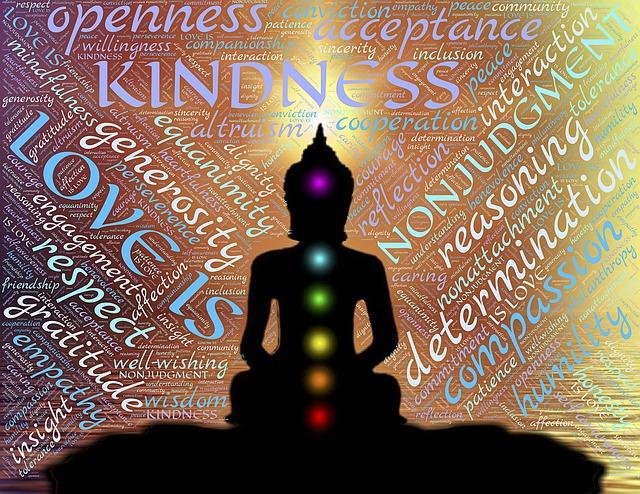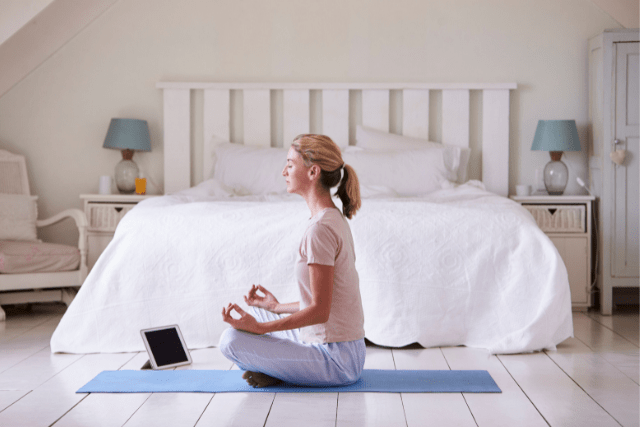Meditation is a practice that has been around for thousands of years, and good reason.
It has been shown to have numerous benefits for both the mind and body, including reducing stress, improving focus and concentration, and promoting overall well-being.
However, starting a meditation routine can be challenging, especially for beginners. With so many different techniques and approaches, it can be difficult to know where to begin.
In this blog post, we will share the 10 best tips for starting a meditation routine so you can experience the many benefits of this ancient practice.
Whether you are a seasoned meditator or a complete beginner, these tips will help you establish a regular meditation practice that will improve your mental and physical health and enhance your overall quality of life.
Set Specific Goals and Intentions
Set clear goals and intentions from the start to make the most of your meditation routine. Having specific goals in mind gives your meditation practice direction and purpose.
Consider what you hope to achieve through meditation. Is it to reduce stress, improve focus, or cultivate inner peace? Whatever it may be, be clear about your intentions and let them guide your practice.
Setting specific goals allows you to measure your progress and stay motivated. It gives you something to work towards and helps you stay committed to your meditation routine.
When you have a clear purpose, it becomes easier to prioritize your practice and make time for it in your daily life.
Having clear intentions helps you stay focused during your meditation sessions. When your mind starts to wander, you can bring your attention back to your goals and remind yourself why you’re meditating in the first place.

Choose a Consistent Time and Place
Once you have set specific goals and intentions for your meditation routine, the next step is to choose a consistent time and place to practice.
Consistency is key when it comes to establishing a meditation habit. By selecting a regular time and place, you create a dedicated space for your practice, making it easier to stick to your routine.
Choose a time of day when you’re least likely to be interrupted or distracted. It could be early in the morning before the hustle and bustle of the day begins or in the evening when things have quieted down.
As for the place, find a quiet and peaceful spot where you feel comfortable and relaxed. It could be a corner in your bedroom, a cozy nook in your living room, or even a serene outdoor setting.
The important thing is that it’s a space where you can fully immerse yourself in your meditation practice without any disturbances.
Start With Short Meditation Sessions
When establishing a meditation routine, starting with short meditation sessions is recommended. Beginning with shorter sessions allows you to build your practice and avoid feeling overwhelmed gradually.
Starting with just a few minutes of daily meditation can help you develop the habit and make it more sustainable in the long run. As you become more comfortable and experienced, you can gradually increase the duration of your sessions.

Find a Comfortable Posture
As you continue building your meditation routine, it’s important to find a comfortable and supportive posture for your practice.
A comfortable posture allows you to relax and focus on your meditation without experiencing unnecessary discomfort or pain. The right posture will enhance your physical comfort and help you achieve a deeper state of relaxation and concentration.
When choosing a posture, consider sitting on a cushion or a chair with your back straight and your shoulders relaxed. You can also try sitting cross-legged on the floor with a cushion or a yoga block for added support.
Experiment with different postures until you find the most comfortable for you. Remember, finding a comfortable posture is essential for a successful meditation practice.
Focus on Your Breath
To deepen your meditation practice, focus on the rhythm and flow of your breath.
As you sit in a comfortable posture, gently close your eyes and bring your focus to the sensation of your breath entering and leaving your body.
Notice the coolness of the inhale as it fills your lungs and the warmth of the exhale as it exits through your nose or mouth. Observe the rise and fall of your abdomen or the expansion and contraction of your chest.
Allow your breath to be your anchor, grounding you in the present moment. Whenever your mind wanders, bring your attention back to your breath.
With regular practice, focusing on your breath will help you cultivate a sense of calm and clarity in your meditation.
Use Guided Meditation Apps or Videos
Consider incorporating guided meditation apps or videos into your meditation routine for a more structured and supported practice. These apps and videos provide a valuable resource for beginners and experienced meditators.
With a wide range of options, you can choose from various styles, techniques, and durations to suit your preferences and needs.
Guided meditation apps and videos offer step-by-step instructions, soothing voices, and calming music, making it easier to focus and relax.
They can help deepen your meditation practice by guiding and holding you accountable.
These resources often include features like progress tracking and reminders, which can help you stay consistent and motivated.

Experiment With Different Meditation Techniques
Try out various meditation techniques to discover what works best for you. Meditation is a personal practice, and what may work for one person may not work for another.
Many different types of meditation techniques are available, such as mindfulness meditation, loving-kindness meditation, and transcendental meditation, to name a few. Each technique has its unique approach and benefits.
By experimenting with different techniques, you can find the one that resonates with you the most and helps you achieve a deeper state of relaxation and focus.
Don’t be afraid to try different techniques and see which brings you peace and clarity.
Be Patient and Gentle With Yourself
Practice patience and kindness toward yourself as you embark on your meditation journey. It’s important to remember that meditation is a practice; like any practice, it takes time and effort to develop.
Be patient as you navigate different meditation techniques and find what works best for you. It’s okay if your mind wanders or you find it difficult to sit still initially. Instead of getting frustrated, gently bring your focus back to your breath or whatever anchor you use.
Remember, meditation is a journey of self-discovery and self-improvement. Treat yourself with compassion and understanding as you cultivate a regular meditation routine.
With time and dedication, you’ll begin to experience the many benefits of meditation.

Create a Meditation Ritual or Routine
To establish a consistent meditation practice, developing a meditation ritual or routine that suits your needs and preferences is essential. Creating a ritual helps signal to your mind and body that it’s time to transition into calm and focus.
Start by choosing a specific time and place for your meditation practice. This could be early in the morning before the day gets busy or in the evening before bed. Find a quiet and comfortable space where you won’t be easily disturbed.
Next, decide on the length of your meditation sessions. Start with shorter sessions, gradually increasing the duration as you become more comfortable.
Incorporate additional elements that enhance your practice, such as lighting a candle, playing soothing music, or using essential oils.
Seek Support and Accountability
When starting a meditation routine, having someone to support you and hold you accountable can greatly increase your chances of success. Find a friend, family member, or colleague interested in meditation and ask them if they’d like to be your meditation buddy.
Enlist a meditation buddy for support and accountability.
Having a buddy can give you the encouragement and motivation to stick to your meditation practice. You can share your experiences, discuss challenges, and celebrate milestones together.
Having someone to meditate with can create a sense of community and make the practice more enjoyable. Whether you meet in person or connect virtually, having a meditation buddy can be a valuable source of support and accountability on your meditation journey.
Frequently Asked Questions
How Do I Set Specific Goals and Intentions for My Meditation Practice?
To set specific goals and intentions for your meditation practice, it’s important to understand what you want to achieve.
Reflect on why you’re meditating and what outcomes you desire.
What Is the Best Time and Place to Meditate?
The best time and place to meditate is subjective. Finding a quiet and comfortable space where you won’t be interrupted is important. Experiment with different times to see what works for you.
How Long Should I Start My Meditation Sessions as a Beginner?
Start your meditation sessions as a beginner for about 10 minutes.
Gradually increase the duration as you become more comfortable.
Remember, consistency is key.
Find a quiet place and make it a daily habit.
What Is the Most Comfortable Posture to Adopt During Meditation?
The most comfortable posture to adopt during meditation allows you to sit with a straight back. This helps to maintain proper alignment and prevents slouching. Additionally, it promotes a sense of alertness and focus.
Relaxed shoulders are also important in achieving a comfortable meditation posture. By letting go of tension in the shoulders, you can feel open and relaxed.
Another aspect to consider is the gaze. A soft gaze, rather than a fixed or intense stare, can help to calm the mind and reduce distractions. It allows you to maintain a sense of awareness without becoming fixated on any particular object or point.
Finding a natural position that supports your concentration is key. Experiment with different postures and adjustments until you find what works best. Remember, the goal is to create a peaceful and comfortable space for your meditation practice.
Are There Any Specific Techniques or Methods I Should Try During Meditation?
Yes, there are many options.
Experiment with guided meditation, focusing on your breath, or using mantras.
Find what works best for you and enjoy the journey.
Conclusion
So, if you’re ready to start a meditation routine, remember to set specific goals, choose a consistent time and place, and start with short sessions.
Find a comfortable posture, focus on your breath, and try different techniques.
Be patient with yourself, create a routine, and seek support if needed.
With these tips, you’ll be well on your way to a successful meditation practice.














Leave a Reply